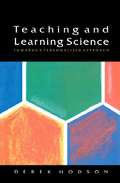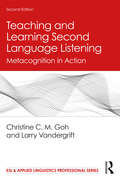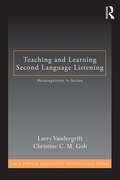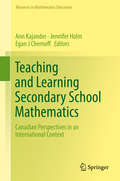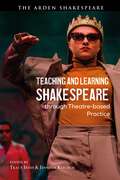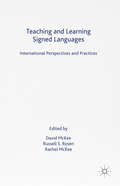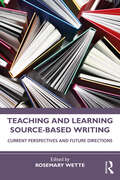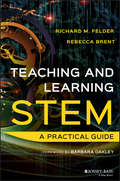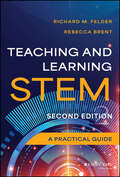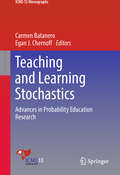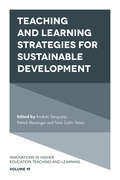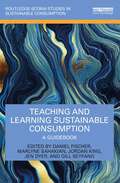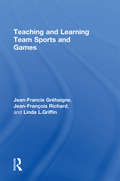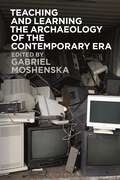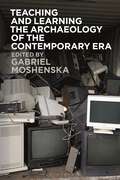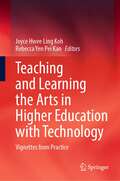- Table View
- List View
Teaching and Learning Science (UK Higher Education OUP Humanities & Social Sciences Education OUP)
by Derek HodsonThis book extends and unifies recent debate and research about science education in several disparate fields, including philosophy of science, cognitive psychology and motivation theory. Through an approach based on the personalization of learning and the politicization of the curriculum and classroom, it shows how the complex goal of critical scientific literacy can be achieved by all students, including those who traditionally underachieve in science or opt out of science education at the earliest opportunity.Current thinking in situated cognition and learning through apprenticeship are employed to build a sociocultural learning model based on a vigorous learning community, in which the teacher acts as facilitator, co-learner and anthropologist. Later chapters describe how these theoretical arguments can be translated into effective classroom practice through a coherent inquiry-oriented pedagogy, involving a much more critical and wide-ranging use of hands-on and language-based learning than is usual in science education.
Teaching and Learning Second Language Listening: Metacognition in Action (ESL & Applied Linguistics Professional Series)
by Christine C. Goh Larry VandergriftNow in its second edition, this reader-friendly text offers a comprehensive treatment of concepts and knowledge related to teaching second language (L2) listening, with a particular emphasis on metacognition. This book advocates a learner-oriented approach to teaching listening that focuses on the process of learning to listen. It applies theories of metacognition and language comprehension to offer sound and reliable pedagogical models for developing learner listening inside and outside the classroom. To bridge theory and practice, the book provides teachers with many examples of research-informed activities to help learners understand and manage cognitive, social, and affective processes in listening. Comprehensively updated with new research and references, the new edition includes additional and expanded discussions of many topics, including metacognition in young learners, working memory, and a L2 listening systems model. It remains an essential text on L2 listening pedagogy, theory, and research.
Teaching and Learning Second Language Listening: Metacognition in Action (ESL & Applied Linguistics Professional Series)
by Christine C. Goh Larry VandergriftNow in its second edition, this reader-friendly text offers a comprehensive treatment of concepts and knowledge related to teaching second language (L2) listening, with a particular emphasis on metacognition. This book advocates a learner-oriented approach to teaching listening that focuses on the process of learning to listen. It applies theories of metacognition and language comprehension to offer sound and reliable pedagogical models for developing learner listening inside and outside the classroom. To bridge theory and practice, the book provides teachers with many examples of research-informed activities to help learners understand and manage cognitive, social, and affective processes in listening. Comprehensively updated with new research and references, the new edition includes additional and expanded discussions of many topics, including metacognition in young learners, working memory, and a L2 listening systems model. It remains an essential text on L2 listening pedagogy, theory, and research.
Teaching and Learning Second Language Listening: Metacognition in Action (ESL & Applied Linguistics Professional Series)
by Larry Vandergrift Christine C.M. GohThis reader-friendly text, firmly grounded in listening theories and supported by recent research findings, offers a comprehensive treatment of concepts and knowledge related to teaching second language (L2) listening, with a particular emphasis on metacognition. The metacognitive approach, aimed at developing learner listening in a holistic manner, is unique and groundbreaking. The book is focused on the language learner throughout; all theoretical perspectives, research insights, and pedagogical principles in the book are presented and discussed in relation to the learner. The pedagogical model?a combination of the tried-and-tested sequence of listening lessons and activities that show learners how to activate processes of skilled listeners ? provides teachers with a sound framework for students’ L2 listening development to take place inside and outside the classroom. The text includes many practical ideas for listening tasks that have been used successfully in various language learning contexts.
Teaching and Learning Second Language Listening: Metacognition in Action (ESL & Applied Linguistics Professional Series)
by Larry Vandergrift Christine C.M. GohThis reader-friendly text, firmly grounded in listening theories and supported by recent research findings, offers a comprehensive treatment of concepts and knowledge related to teaching second language (L2) listening, with a particular emphasis on metacognition. The metacognitive approach, aimed at developing learner listening in a holistic manner, is unique and groundbreaking. The book is focused on the language learner throughout; all theoretical perspectives, research insights, and pedagogical principles in the book are presented and discussed in relation to the learner. The pedagogical model─a combination of the tried-and-tested sequence of listening lessons and activities that show learners how to activate processes of skilled listeners ─ provides teachers with a sound framework for students’ L2 listening development to take place inside and outside the classroom. The text includes many practical ideas for listening tasks that have been used successfully in various language learning contexts.
Teaching and Learning Secondary School Mathematics: Canadian Perspectives In An International Context (Advances in Mathematics Education)
by Ann Kajander Jennifer Holm Egan J ChernoffThis volume brings together recent research and commentary in secondary school mathematics from a breadth of contemporary Canadian and International researchers and educators. It is both representative of mathematics education generally, as well as unique to the particular geography and culture of Canada. The chapters address topics of broad applicability such as technology in learning mathematics, recent interest in social justice contexts in the learning of mathematics, as well as Indigenous education. The voices of classroom practitioners, the group ultimately responsible for implementing this new vision of mathematics teaching and learning, are not forgotten. Each section includes a chapter written by a classroom teacher, making this volume unique in its approach. We have much to learn from one another, and this volume takes the stance that the development of a united vision, supported by both research and professional dialog, provides the first step.
Teaching and Learning Shakespeare through Theatre-based Practice
by Tracy Irish and Jennifer KitchenHow can the study of Shakespeare contribute to equipping young people for the challenges of an uncertain future? This book argues for the necessity of a Shakespeare education that: finds meaning in the texts through inviting in the prior knowledge, experiences and ideas of students; combines intellectual, social and emotional learning; and develops a critical perspective on what a cultural inheritance is all about. It offers a comprehensive exploration of the educational principles underpinning theatre-based practice and explains how and why this practice can open up the possibilities of Shakespeare study in the classroom. It empowers Shakespeare educators working with young people aged 5-18 to interact critically, creatively and collaboratively with Shakespeare as a living artist.Drawing on the authors' research and experience with organizations including the Royal Shakespeare Company, Shakespeare's Globe, the Folger and Coram Shakespeare Schools Foundation, Part One consolidates recent developments in the field and engages in lively dialogue with core questions of Shakespeare's place in the classroom. Part Two curates a series of interviews with leaders and practitioners from the above and other Shakespeare institutions, exploring their core principles and practices. Part Three presents chapters from and about classroom teachers, who share their experiences of successfully embedding theatre-based approaches to Shakespeare in their own diverse contexts.
Teaching and Learning Shakespeare through Theatre-based Practice
How can the study of Shakespeare contribute to equipping young people for the challenges of an uncertain future? This book argues for the necessity of a Shakespeare education that: finds meaning in the texts through inviting in the prior knowledge, experiences and ideas of students; combines intellectual, social and emotional learning; and develops a critical perspective on what a cultural inheritance is all about. It offers a comprehensive exploration of the educational principles underpinning theatre-based practice and explains how and why this practice can open up the possibilities of Shakespeare study in the classroom. It empowers Shakespeare educators working with young people aged 5-18 to interact critically, creatively and collaboratively with Shakespeare as a living artist.Drawing on the authors' research and experience with organizations including the Royal Shakespeare Company, Shakespeare's Globe, the Folger and Coram Shakespeare Schools Foundation, Part One consolidates recent developments in the field and engages in lively dialogue with core questions of Shakespeare's place in the classroom. Part Two curates a series of interviews with leaders and practitioners from the above and other Shakespeare institutions, exploring their core principles and practices. Part Three presents chapters from and about classroom teachers, who share their experiences of successfully embedding theatre-based approaches to Shakespeare in their own diverse contexts.
Teaching and Learning Signed Languages: International Perspectives and Practices
by Russell S. Rosen David McKee Rachel McKeeTeaching and Learning Signed Languages examines current practices, contexts, and the research nexus in the teaching and learning of signed languages, offering a contemporary, international survey of innovations in this field.
Teaching and Learning Source-Based Writing: Current Perspectives and Future Directions
by Rosemary WetteThis volume brings together significant findings, approaches, and research-based pedagogies on teaching and learning source-based writing. A comprehensive update to the field, this book presents source-based writing as an essential skill that comes with its own specific set of challenges, requiring a complex set of literacy skills and capabilities for mastery. With contributors from leading scholars from around the world, the volume addresses source-based writing as a developmental issue and offers guidance for supporting novice academic writers on their path toward proficiency and accumulation of multifaceted skill set. Chapters cover key topics, including metacognitive skills, the flipped classroom, scaffolding, assessment, and ethical considerations. With research reviews, practical considerations and future directions as components of each chapter, this book is ideal for courses on academic writing and second language writing.
Teaching and Learning Source-Based Writing: Current Perspectives and Future Directions
This volume brings together significant findings, approaches, and research-based pedagogies on teaching and learning source-based writing. A comprehensive update to the field, this book presents source-based writing as an essential skill that comes with its own specific set of challenges, requiring a complex set of literacy skills and capabilities for mastery. With contributors from leading scholars from around the world, the volume addresses source-based writing as a developmental issue and offers guidance for supporting novice academic writers on their path toward proficiency and accumulation of multifaceted skill set. Chapters cover key topics, including metacognitive skills, the flipped classroom, scaffolding, assessment, and ethical considerations. With research reviews, practical considerations and future directions as components of each chapter, this book is ideal for courses on academic writing and second language writing.
Teaching and Learning STEM: A Practical Guide
by Richard M. Felder Rebecca BrentRethink traditional teaching methods to improve student learning and retention in STEM Educational research has repeatedly shown that compared to traditional teacher-centered instruction, certain learner-centered methods lead to improved learning outcomes, greater development of critical high-level skills, and increased retention in science, technology, engineering, and mathematics (STEM) disciplines. Teaching and Learning STEM presents a trove of practical research-based strategies for designing and teaching STEM courses at the university, community college, and high school levels. The book draws on the authors' extensive backgrounds and decades of experience in STEM education and faculty development. Its engaging and well-illustrated descriptions will equip you to implement the strategies in your courses and to deal effectively with problems (including student resistance) that might occur in the implementation. The book will help you: Plan and conduct class sessions in which students are actively engaged, no matter how large the class is Make good use of technology in face-to-face, online, and hybrid courses and flipped classrooms Assess how well students are acquiring the knowledge, skills, and conceptual understanding the course is designed to teach Help students develop expert problem-solving skills and skills in communication, creative thinking, critical thinking, high-performance teamwork, and self-directed learning Meet the learning needs of STEM students with a broad diversity of attributes and backgrounds The strategies presented in Teaching and Learning STEM don't require revolutionary time-intensive changes in your teaching, but rather a gradual integration of traditional and new methods. The result will be continual improvement in your teaching and your students' learning. More information about Teaching and Learning STEM can be found at http://educationdesignsinc.com/book including its preface, foreword, table of contents, first chapter, a reading guide, and reviews in 10 prominent STEM education journals.
Teaching and Learning STEM: A Practical Guide
by Richard M. Felder Rebecca BrentRethink traditional teaching methods to improve student learning and retention in STEM Educational research has repeatedly shown that compared to traditional teacher-centered instruction, certain learner-centered methods lead to improved learning outcomes, greater development of critical high-level skills, and increased retention in science, technology, engineering, and mathematics (STEM) disciplines. Teaching and Learning STEM presents a trove of practical research-based strategies for designing and teaching STEM courses at the university, community college, and high school levels. The book draws on the authors' extensive backgrounds and decades of experience in STEM education and faculty development. Its engaging and well-illustrated descriptions will equip you to implement the strategies in your courses and to deal effectively with problems (including student resistance) that might occur in the implementation. The book will help you: Plan and conduct class sessions in which students are actively engaged, no matter how large the class is Make good use of technology in face-to-face, online, and hybrid courses and flipped classrooms Assess how well students are acquiring the knowledge, skills, and conceptual understanding the course is designed to teach Help students develop expert problem-solving skills and skills in communication, creative thinking, critical thinking, high-performance teamwork, and self-directed learning Meet the learning needs of STEM students with a broad diversity of attributes and backgrounds The strategies presented in Teaching and Learning STEM don't require revolutionary time-intensive changes in your teaching, but rather a gradual integration of traditional and new methods. The result will be continual improvement in your teaching and your students' learning. More information about Teaching and Learning STEM can be found at http://educationdesignsinc.com/book including its preface, foreword, table of contents, first chapter, a reading guide, and reviews in 10 prominent STEM education journals.
Teaching and Learning STEM: A Practical Guide
by Richard M. Felder Rebecca BrentThe widely used STEM education book, updated Teaching and Learning STEM: A Practical Guide covers teaching and learning issues unique to teaching in the science, technology, engineering, and math (STEM) disciplines. Secondary and postsecondary instructors in STEM areas need to master specific skills, such as teaching problem-solving, which are not regularly addressed in other teaching and learning books. This book fills the gap, addressing, topics like learning objectives, course design, choosing a text, effective instruction, active learning, teaching with technology, and assessment—all from a STEM perspective. You’ll also gain the knowledge to implement learner-centered instruction, which has been shown to improve learning outcomes across disciplines. For this edition, chapters have been updated to reflect recent cognitive science and empirical educational research findings that inform STEM pedagogy. You’ll also find a new section on actively engaging students in synchronous and asynchronous online courses, and content has been substantially revised to reflect recent developments in instructional technology and online course development and delivery. Plan and deliver lessons that actively engage students—in person or online Assess students’ progress and help ensure retention of all concepts learned Help students develop skills in problem-solving, self-directed learning, critical thinking, teamwork, and communication Meet the learning needs of STEM students with diverse backgrounds and identitiesThe strategies presented in Teaching and Learning STEM don’t require revolutionary time-intensive changes in your teaching, but rather a gradual integration of traditional and new methods. The result will be a marked improvement in your teaching and your students’ learning.
Teaching and Learning STEM: A Practical Guide
by Richard M. Felder Rebecca BrentThe widely used STEM education book, updated Teaching and Learning STEM: A Practical Guide covers teaching and learning issues unique to teaching in the science, technology, engineering, and math (STEM) disciplines. Secondary and postsecondary instructors in STEM areas need to master specific skills, such as teaching problem-solving, which are not regularly addressed in other teaching and learning books. This book fills the gap, addressing, topics like learning objectives, course design, choosing a text, effective instruction, active learning, teaching with technology, and assessment—all from a STEM perspective. You’ll also gain the knowledge to implement learner-centered instruction, which has been shown to improve learning outcomes across disciplines. For this edition, chapters have been updated to reflect recent cognitive science and empirical educational research findings that inform STEM pedagogy. You’ll also find a new section on actively engaging students in synchronous and asynchronous online courses, and content has been substantially revised to reflect recent developments in instructional technology and online course development and delivery. Plan and deliver lessons that actively engage students—in person or online Assess students’ progress and help ensure retention of all concepts learned Help students develop skills in problem-solving, self-directed learning, critical thinking, teamwork, and communication Meet the learning needs of STEM students with diverse backgrounds and identitiesThe strategies presented in Teaching and Learning STEM don’t require revolutionary time-intensive changes in your teaching, but rather a gradual integration of traditional and new methods. The result will be a marked improvement in your teaching and your students’ learning.
Teaching and Learning Stochastics: Advances in Probability Education Research (ICME-13 Monographs)
by Carmen Batanero Egan J ChernoffThis book presents a collection of selected papers that represent the current variety of research on the teaching and learning of probability. The respective chapters address a diverse range of theoretical, empirical and practical aspects underpinning the teaching and learning of probability, curricular issues, probabilistic reasoning, misconceptions and biases, as well as their pedagogical implications. These chapters are divided into THREE main sections, dealing with: TEACHING PROBABILITY, STUDENTS' REASONING AND LEARNING AND EDUCATION OF TEACHERS.In brief, the papers presented here include research dealing with teachers and students at different levels and ages (from primary school to university) and address epistemological and curricular analysis, as well as the role of technology, simulations, language and visualisation in teaching and learning probability. As such, it offers essential information for teachers, researchers and curricular designers alike.
Teaching and Learning Strategies for Sustainable Development (Innovations in Higher Education Teaching and Learning #19)
by Enakshi Sengupta Patrick Blessinger Taisir Subhi YaminThe United Nations Sustainable Development Goals challenges us all to promote sustainable development. Higher education is a key arena for educating students in sustainability and sustainable developments, and for producing research on these key issues.. This timely book explores the sustainable development goals, how well universities have been able to integrate them into their curriculum, and how universities can institutionalize the goals and sustainable development into their strategic plans and institutional culture. Authors from Nigeria, sub Saharan Africa, Italy and the Middle East explore how to achieve these targets in the face of shifting expectations.
Teaching and Learning Strategies for Sustainable Development (Innovations in Higher Education Teaching and Learning #19)
by Enakshi Sengupta Patrick Blessinger Taisir Subhi YaminThe United Nations Sustainable Development Goals challenges us all to promote sustainable development. Higher education is a key arena for educating students in sustainability and sustainable developments, and for producing research on these key issues.. This timely book explores the sustainable development goals, how well universities have been able to integrate them into their curriculum, and how universities can institutionalize the goals and sustainable development into their strategic plans and institutional culture. Authors from Nigeria, sub Saharan Africa, Italy and the Middle East explore how to achieve these targets in the face of shifting expectations.
Teaching and Learning Sustainable Consumption: A Guidebook (Routledge-SCORAI Studies in Sustainable Consumption)
by Daniel Fischer Marlyne Sahakian Jordan King Jen Dyer Gill SeyfangThis book is a comprehensive guide on how to teach sustainable consumption in higher education. Teaching and Learning Sustainable Consumption: A Guidebook systematizes the themes, objectives, and theories that characterize sustainable consumption as an educational field. The first part of the book discusses approaches to teaching and learning sustainable consumption in higher education, including reflections on how learning occurs, to more practical considerations like how to set objectives or assess learning outcomes. The second part of the book is a dive into inspiring examples of what this looks like in a range of contexts and towards different aims – involving 57 diverse contributions by teachers and practitioners. Building on the momentum of a steady increase in courses addressing sustainable consumption over the past decade, this guidebook supports innovative approaches to teaching and learning, while also bringing to the fore conceptual debates around higher education and sustainability. Overall, this book will be a seminal resource for educators teaching about sustainability and consumption. It will help them to navigate the specifics of sustainable consumption as a field of scholarship, and design their teaching approaches in a more informed, competent, and creative way.
Teaching and Learning Sustainable Consumption: A Guidebook (Routledge-SCORAI Studies in Sustainable Consumption)
This book is a comprehensive guide on how to teach sustainable consumption in higher education. Teaching and Learning Sustainable Consumption: A Guidebook systematizes the themes, objectives, and theories that characterize sustainable consumption as an educational field. The first part of the book discusses approaches to teaching and learning sustainable consumption in higher education, including reflections on how learning occurs, to more practical considerations like how to set objectives or assess learning outcomes. The second part of the book is a dive into inspiring examples of what this looks like in a range of contexts and towards different aims – involving 57 diverse contributions by teachers and practitioners. Building on the momentum of a steady increase in courses addressing sustainable consumption over the past decade, this guidebook supports innovative approaches to teaching and learning, while also bringing to the fore conceptual debates around higher education and sustainability. Overall, this book will be a seminal resource for educators teaching about sustainability and consumption. It will help them to navigate the specifics of sustainable consumption as a field of scholarship, and design their teaching approaches in a more informed, competent, and creative way.
Teaching and Learning Team Sports and Games
by Jean-Francis Gréhaigne Jean-François Richard Linda L. GriffinWritten as a resource for both pre-service and in-service educators, this theory-to-practice book focuses on the foundations and applications of constructivism applied to the teaching and learning of invasion sports and games.
Teaching and Learning Team Sports and Games
by Jean-Francis Gréhaigne Jean-François Richard Linda L. GriffinWritten as a resource for both pre-service and in-service educators, this theory-to-practice book focuses on the foundations and applications of constructivism applied to the teaching and learning of invasion sports and games.
Teaching and Learning the Archaeology of the Contemporary Era
by Gabriel MoshenskaThe tools and techniques of archaeology were designed for the study of past people and societies, but for more than a century a growing number of archaeologists have turned these same tools to the study of the modern world. This book offers an overview of these pioneering practices through a specifically pedagogical lens, fostering an appreciation of the diversity and distinctiveness of contemporary archaeology and providing an evidence base for course proposals and curriculum design.Although research in the field is well established and vibrant, making critical contributions to wider debates around issues such as homelessness, migration and the refugee crisis, and legacies of war and conflict, the teaching of contemporary archaeology in universities has until recently been relatively limited in comparison. This selection of carefully curated case studies from as far afield as Orkney, Iran and the USA is intended as a resource and an inspiration for both teachers and students, presenting a set of tools and practices to borrow, modify and apply in new contexts. It demonstrates how interdisciplinarity, practical work and radical pedagogies are of value not only for archaeology, but also for fields such as history, geography and anthropology, and suggests new ways in which we can examine our 20th- and 21st-century existence and shape our collective future.
Teaching and Learning the Archaeology of the Contemporary Era
The tools and techniques of archaeology were designed for the study of past people and societies, but for more than a century a growing number of archaeologists have turned these same tools to the study of the modern world. This book offers an overview of these pioneering practices through a specifically pedagogical lens, fostering an appreciation of the diversity and distinctiveness of contemporary archaeology and providing an evidence base for course proposals and curriculum design.Although research in the field is well established and vibrant, making critical contributions to wider debates around issues such as homelessness, migration and the refugee crisis, and legacies of war and conflict, the teaching of contemporary archaeology in universities has until recently been relatively limited in comparison. This selection of carefully curated case studies from as far afield as Orkney, Iran and the USA is intended as a resource and an inspiration for both teachers and students, presenting a set of tools and practices to borrow, modify and apply in new contexts. It demonstrates how interdisciplinarity, practical work and radical pedagogies are of value not only for archaeology, but also for fields such as history, geography and anthropology, and suggests new ways in which we can examine our 20th- and 21st-century existence and shape our collective future.
Teaching and Learning the Arts in Higher Education with Technology: Vignettes from Practice
by Joyce Hwee Ling Koh Rebecca Yen Pei KanThis book is an inquiry about the possibilities of using technology to support the education of artists within higher education contexts. Even though technology-enhanced learning and teaching may seem incongruent with the long-established studio-based cultures of making and performing, it is increasingly becoming a pivotal point to connect artistes to potential audience and markets. Amidst the COVID-19 pandemic, technology is also the crucial linchpin for educational continuity of student artists. This book explores how technology could enhance the education of artists and designers as they continue to create, make, and add value to life and society through their artistry. It draws upon the experiences of the Nanyang Academy of Fine Arts (NAFA), a pioneering arts institution in Singapore with over 80 years of institutional history. Through 9 vignettes, this book illustrates technology-enhanced pedagogical practices that have been implemented in different artistic learning spaces including classroom, studio, and stage as well as institutional support strategies. With a naturalistic stance, these chapters seek to illuminate realistic pictures of teaching and learning that are being uncovered by artist educators as they sought to integrate technology within teaching practices using available technologies and within the classes that they are teaching. It is hoped that this book will stimulate conversation among artist educators about possible pedagogical models, as well as inform higher arts institutions about the contextual strategies needed to support the creation of technology-enhanced pedagogical practices.
